Movies from around India have shot romantic duets on the snowy slopes and among the pine trees of Kashmir. But it is only when you take in the beauty of Kashmir with your own eyes that you realise how really beautiful it is. In the middle of the valley is a system of lakes and the Jhelum river, around which the capital city Srinagar has evolved. The city has really old roots, going well back to the days when Takshila University was a hub for students around the world to flock to. There is so much to see and do at Srinagar, but at the same time, it is just enough to sit down, relax and simply soak in the ambience of the Dal Lake and the snow-capped peaks surrounding it. Here is what we learned about Srinagar during our visit, along with a list of what you can do there.
Geography of Srinagar
Kashmir is a maze of high-peaked snow mountains interspersed with large flat valleys that have a number of major rivers and lakes. Among one such flat expanse of land that contains the Dal Lake and the Jhelum river, the city of Srinagar has grown to what it is today. Dal is one of the many lakes in Srinagar. There are others like Nigeen and Wular, all connected to each other by canals. Based on the lakes and their banks, we can classify Srinagar into two parts: the city on land and the city that thrives in water. That’s true. Along with the part of Srinagar’s landmass that stretches from Ganderbal suburb in the north to Badgam in the south, there is a complete settlement that lives inside the lake itself, with unique areas like Meena market and Char Chinar island.

Scenes like these are plentiful in Kashmir. Flat tracts of land with acres of cultivated farms. It is a fallacy that the whole of Kashmir is mountainous, bitterly cold and covered in snow. Rivers like Jhelum ensure that the valley lying at lower altitudes are fertile and green.
To the south and south-east of Srinagar is the flat expanse of Kashmir valley, highlighted by large farmlands which grow saffron, apples, fruits and vegetables. To the west of Srinagar are the mountains that lead to Gulmarg hill station and its skiing institute. To the north, you will come across Himalayan mountains that are sparsely inhabited and lead to the Line of Control with Pakistan. Driving to the east of Srinagar, you can reach other interesting destinations such as Sonmarg, Kargil and Ladakh. The Jhelum river, that originates at Wular lake and flows near the Lal Chowk junction, marks the end of Lake Area Development Authority of Srinagar and seperates the city from the southern suburbs.
In Kashmir valley, one can spot many varieties of pine trees, but the one that is most revered is the Chinar tree, with its clovered leaf looking like a Canadian maple. Chinar is sometimes referred to as the Indian maple.
People of Srinagar
While the name Srinagar has Hindu roots, majority of the city is Islamic. They are the Kashmiri Muslims who are locally called ‘Koshur’. Ramzan is an important month for Kashmiri Muslims just like Muslims around the world. Without getting controversial, let me just state that the other ethnic group, Kashmiri Hindu Pandits, are very few in numbers in Kashmir region itself and are rare to come across anymore. You can also find Sikhs in Sikh colonies around Kashmir.
Kashmiris speak Kashmiri language which is a descendent of Farsi tongue from Iran. During India 360, we found Kashmiri to be the sweetest and the best sounding language. Hands down. No other Indian language, the way it is spoken on the streets, comes close to the melody that day-to-day Kashmiri produces. It is easy to assume that Hindi is spoken throughout Kashmir. But in reality, what you hear is Urdu. It is common for people to use terms like ‘Janab’ when they address you. The two languages are identical to hear. But Hindi uses Devnagari script and plenty of Sanskrit words, whereas Urdu uses Arabic script and plenty of words derived from Arabic, Farsi and Afghan. The youth of Kashmir are very fluent in English too.
Kashmiris have plenty of occupations. Most people are connected to agriculture and the processing and trade of agricultural products. The highest selling agricultural product are Kashmiri saffron, Kashmiri apples and Rose Gulkand. Other fruits and nuts like apricots, figs, almonds and walnuts are also grown and traded here. Exquisite wood carving, elaborate carpet weaving and the production of woollen bedsheets and blankets, especially with Pashmina wool are major and flourishing occupations for the people here.
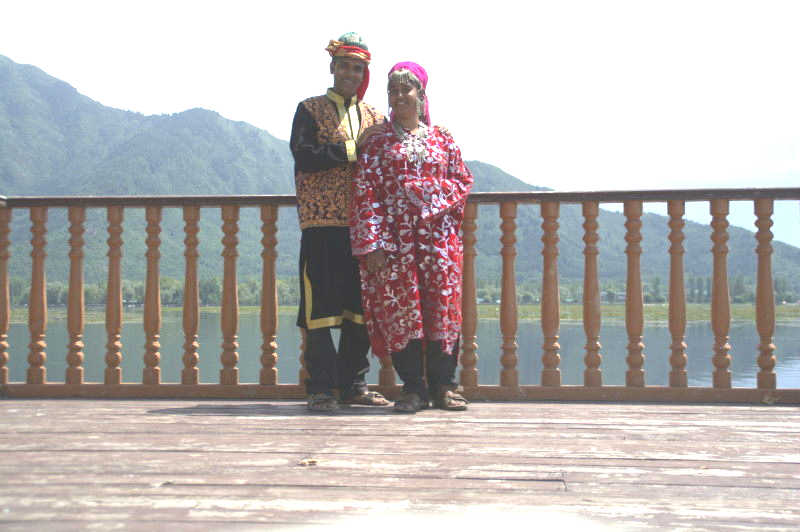
We are not Kashmiri, but we got to dress up like them 🙂
Let’s now look at the places to visit in Srinagar
Dal lake boat ride
if you are given just one day in Srinagar, then this is what you should do. Taking a boat ride in one of the local boats, named shikaras, is a unique experience and can only be done in Srinagar. The magnificently constructed boats have a curtained chamber and you can just sit back and relax while the boatman takes you on a ride around Dal and Nigeen lakes. On the way, you’ll be shown landmarks like Hazratbal, areas like Rainawari, the view of the snowcaps around Gulmarg and the lake market called Meena Bazaar. Dal lake boat ride should be the one thing you should not miss when in Srinagar. You can get shikaras on the eastern bank of the lake, at one of the gates that face the main road, which is called the Boulevard road.
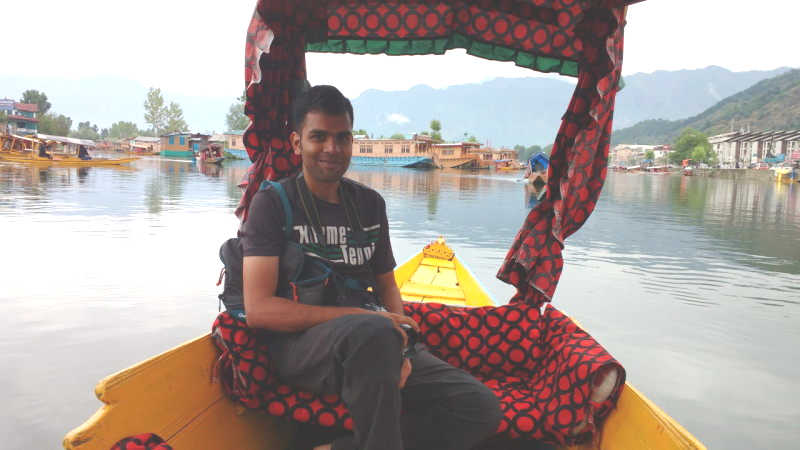
Dal lake shikara ride
The only caveat about these rides is that there are too many vendors. Too many jewellery sellers, snacks sellers, flower sellers and spice sellers approach your shikara and sell hard to get you to buy their wares. Thankfully, these are restricted to the lake area closer to the city. Once you leave the city and are in the depths of the lake, you will only find mangrove shades and migratory birds. Snow-capped mountains in front of you and a tranquil peace around you. It’s hard to say whether you should keep your eyes open for the beauty around you or keep your eyes shut to enjoy the tranquility. That’s confusing. But the one certain is NOT to TALK during a tranquil shikara ride. The song from Mission Kashmir, ‘Chup ke se sunn, is pal di dhun’ (Hindi song that says: Stay silent and listen to the tunes of this moment) rings true.
Dal lake boathouse stay
A boat ride will show you around the lake, but what about staying inside the lake itself. You should check out the boathouses that line the Dal Lake gates 1 – 10 (eastern bank of the lake). These are entry level boat houses, but still look fabulous, with their wood carved bed headboards and window frames. For breakfast, you will be served Kashmiri bread and Nun Chai, which is a salty version of tea, slightly pinkish in colour. Then comes the exotic tasting Kahwa, a non-milky tea infused with the taste of saffron and cardamom. It is customary for Kashmiris to treat special guests with a cup of kahwa and you will be treated no less than a very special guest.

Enjoying the idle and beautiful setting of a Kashmiri boathouse on Dal lake.
But the best thing to do on a boathouse is to take one of seats along the verandah and sit gazing at the lake and the city. It is quite relaxing.
Mughal-style gardens
Being a city ruled for long by Muslim monarchs, you can expect their landscaped lawns, rose gardens and fountains to crop up around the city. Haider Ali and Tipu Sultan, while ruling over Srirangapatna for just 49 years between them, built a palace and a garden. Then what can you say about Srinagar? Well, there are 5 Mughal style gardens around Srinagar, all in different areas. But the theme in each of them is the same. Lawns, rose beds and multi-coloured flower beds in multiple terraces at increasing levels, with water fed by a central fountain. The five Mughal style gardens are: Mughal Bagh, Shalimar Bagh, Nishat Bagh, Chashme Shahi Bagh and Badamwari.
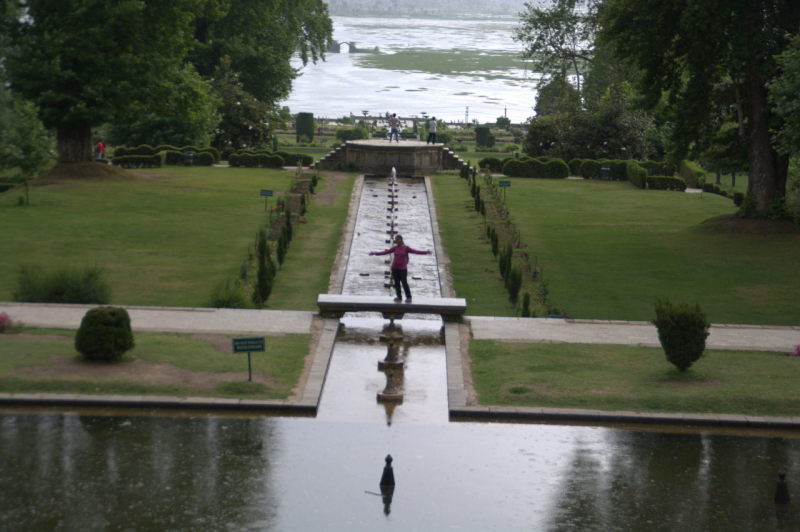
Nishat Bagh is very close to Dal lake.
Each of these gardens were built either by the incumbent rulers or by their ministers, mostly as a statement to exhibit their artistic taste. These were mostly a show of one-upmanship as the latest garden was built in more opulent a style than the last one. But who are we to care? The intense competition makes it great for us to visit Srinagar and feast our eyes upon beautiful fountains and magnificent flowers.
Hari Parbat
Hari Parbat is a hill on the western bank of Dal Lake, opposite to the side you usually embark on boat rides. The name of the hill is due to the fact that the fort at the top was used by the last monarch of Jammu Kashmir, Raja Hari Singh. The fort at the top of the hill was built by Mughal emperor Akbar. There is also a Gurudwara, a dargah and a temple. The hill can be reached by bus or Sumo taxi that is bound to Rainawari. You should alight at ‘Maqdoom Sahib ropeway’. A little distance ahead is a narrow road that winds up the hill. After a kilometre uphill, the road ends and a stairway starts. This stairway goes all the way to the top, with branching stairways to important points along the way. The hill is now patrolled by the Indian Army, who have a vantage view of the entire city from here.
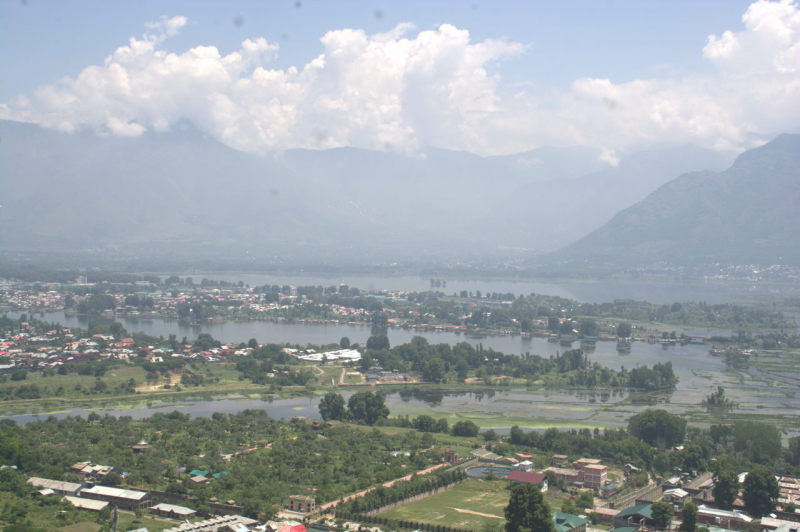
The city of lakes is in full display from the top of the Akbar fort, along with the surrounding Himalayas.
Akbar fort has bastions with viewpoints towards Srinagar. There are also dungeons and a place for execution. Another important place is the Swayambhu (self-formed) temple of Lord Shakti called Sharika Devi, a deity with 18 arms.
Dargah Maqdoom Sahib is on the side of the hill away from the staircase and can be reached by taking a ropeway from the base.
Shankararchya Hill
While Hari Parbat is to the west of the lake, Shankaracharya Hill is to the east, the same side as the gate for shikaras and also the side where you can visit most of the Mughal-style gardens. Thus, it makes sense to combine this hill with a boat ride and garden visits, while Hari Parbat and Badamwari garden (the only Mughal garden to the west of the lake) should be combined with a visit to Rainawari old town.
Adi Shankaracharya performed his own version of ‘India 360’, but during the 8th century, with no motor transport, no trains, no personal vehicle or planes. This revered man went to several places teaching the principles of Hinduism and establishing some of the most important temples in India. One of them is the Jyeshteshwara temple at the top of the hill that faces Srinagar from the east. Today we know this hill to be the Shankaracharya hill.
Rainawari and Hazratbal
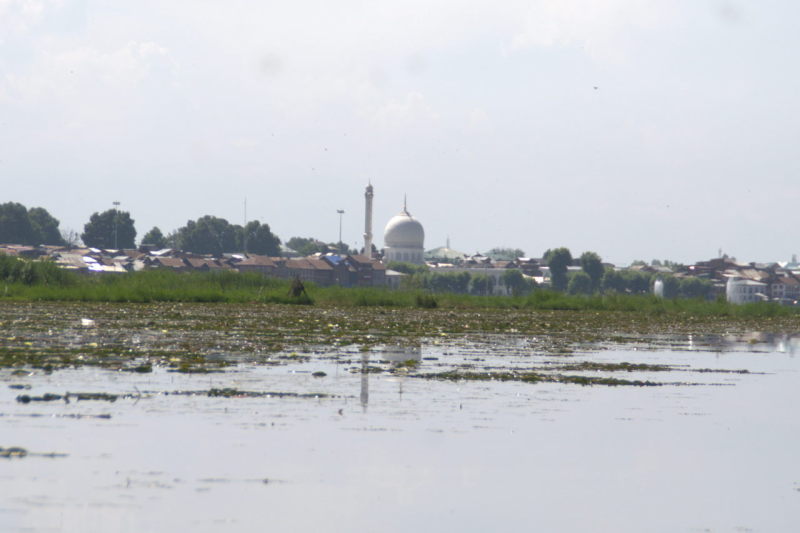
A view of Hazratbal from Dal Lake.
Hazratbal is a holy mosque in Rainawari township on the western bank of Dal lake. This area is the traditional Srinagar with old houses and narrow streets that have developed organically over centuries, rather than the highways and modern buildings on the east that has been developed recently by LADA (Lake Area Development Authority). LADA has left Rainawari alone to preserve it in its traditional state.
Hazratbal is considered holy among Muslims as the mosque that is home to Prophet Mohammad’s hair. While no one is allowed to see the Holy Hair on normal days, it is brought out for public viewing on special days such as the Prophet’s birthday as per the Muslim calendar.
Boulevard road
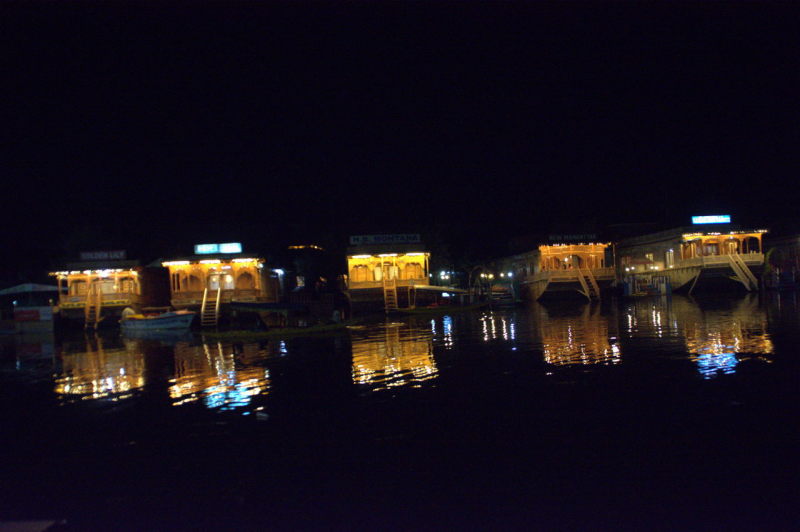
Houseboats in Dal lake at night, as seen from Boulevard road.
If you are not in a mood for sight-seeing, you can simply take a walk on the portion of the Boulevard road that runs parallel to the Dal lake’s eastern side for several kilometres. Of significance is the portion between Dal Gate 1, where the road starts, upto Nishat Garden. It is quite a sight to see multi-coloured boats floating on the water.
Meena Bazaar
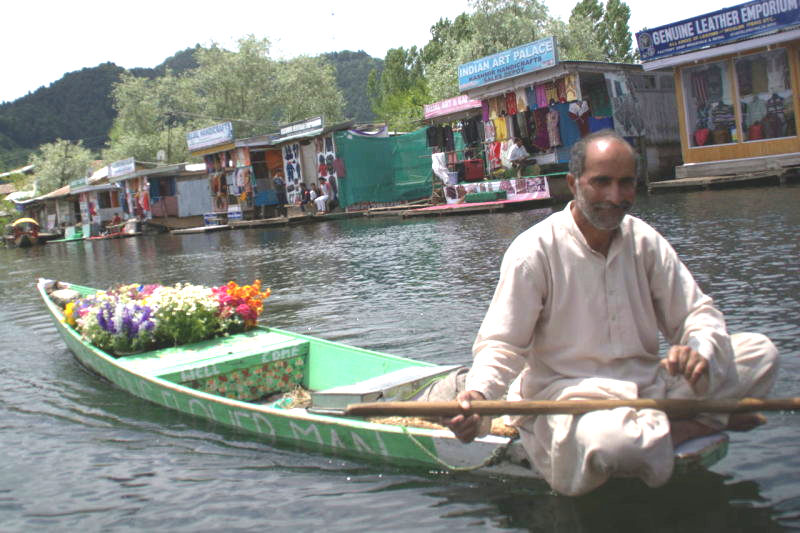
A flower seller on his boat in Meena Bazaar.
When you take a boat ride in a shikara, the boatman will inevitably take you through Meena Bazaar, a floating market where vegetables, fruits, flowers and handicrafts are sold from boats that act as shops. We bought a Pashmina bedsheet from Meena Bazaar.
Rainawari lakeside shops
While Meena Bazaar is a floating market, the Rainawari Bazaar is a regular market on land, but with a difference. At Rainawari, the Dal lake narrows down into a canal that feeds into the Nigeen lake. On both sides of the canal, you can see shops that sell food, handicrafts and fresh produce. Of significance in this market, are apiaries that sell fresh honey produced from different types of flowers. Each honey has a health benefit for different parts of the body. Along with honey, the apiaries also sell beeswax.
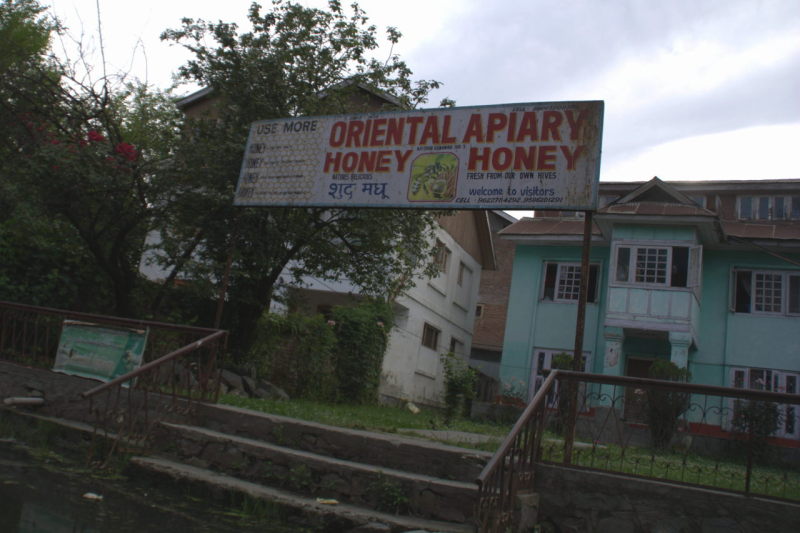
Oriental apiary is a business where different varieties of honey are extracted by breeding cultures of bees. This apiary has been running for several years at Rainawari, the old part of Srinagar city.
What to eat
If I were to write in detail about Kashmiri food, it would run into a seperate blog. So let me keep the list concise with really short descriptions.
For non-vegetarians: Lamb kebab, tandoori chicken, fresh lake fish. We are vegetarians, so we can’t comment on the quality and taste.
Kashmiri pulav: is a slightly sweeter version of the regular pulav, because it has dry fruits like raisins added. We had Kashmiri pulav once, but then stuck to regular veg pulav otherwise.
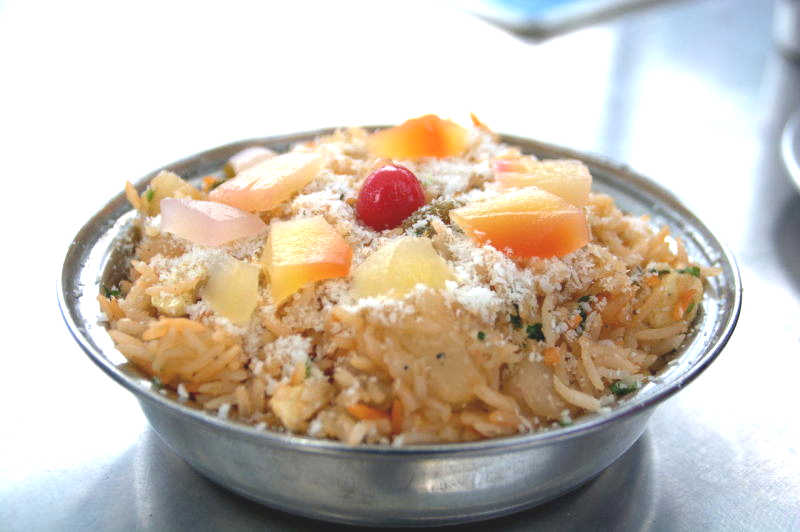
Kashmiri pulav is a variant of the traditional Indian pulav, with garnishing like fresh fruits, dry fruits and coconut kernel. The pulav tastes slightly sweet and can be had with spicy gravy.
Bakery: As with all Muslim territories, there is an assortment of baked delicacies in Kashmir, although all of them use egg yolk. Kashmiri bread, pastries, cookies, mawa cake and nankhatais are all really delicious.
Kahwa (DO NOT MISS): At least once during your Kashmiri trip, you MUST have a cup of Kahwa. Kahwa is milkless tea infused with saffron and cardamom.
Nun Chai: is a tea-based beverage that is pinkish in colour and is salty.
Gulbadan: is an ice cream that looks similar to kulfi. Gulbadan is made of milk, khoa and Gulkand (e.g. rose pulp).
What to buy
Kashmir has so many souvenirs, that you’d need a seperate bag to carry them. Here are some things that you can consider buying. If you are purchasing a large item, then Kashmiri traders have the option of shipping it to your home address without you having to carry them.
Pashmina wool products: Pashmina is a special type of wool that is extremely soft. You can buy shawls, bedsheets and blankets made of Pashmina. These aren’t of use if you stay in a place that remains warm even in winter, e.g. coastal peninsular Indian cities such as Mumbai, Chennai, Kochi or Kanyakumari. But at least they feel very soft and rich, even if there is no cold to protect you from.
Spices and tea: You can definitely load up on spices, especially SAFFRON. Nowhere in India will you get saffron for the price that you get in Srinagar. In fact, Pampore village, just 11 km south-east of Srinagar, has some of the biggest saffron fields in Kashmir. So the spice is produced hyper-locally and sold without the complication of packaging and preservation. You will even get them during a shikara boatride. Be aware that not all saffron is Kashmiri saffron. Some of them are cheap imports from Iran. If you put a strand of saffron on your palm and wet the strand with a drop of water, there should be a deep saffron colour residue on your palm. If your palm isn’t coloured or if the colour is too light, then the spice is a cheap duplicate.
You can also buy boxes of Kahwa tea, that you can boil with water and spices and serve at home.
Carved wooden boxes: Wood carving in Kashmir is one of the most admirable art forms you’ll ever see. In fact, Srinagar railway station has carved wood panels that make the station really beautiful. You can buy small boxes for keeping spices or ornaments.
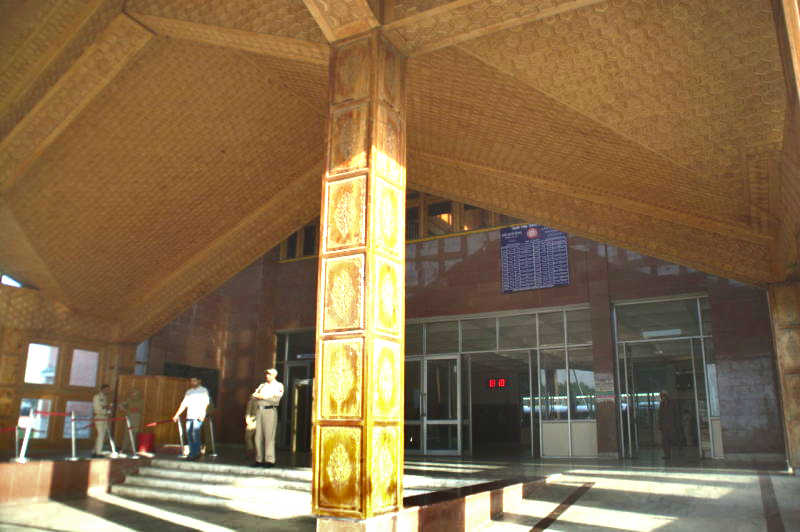
Srinagar railway station is an excellent exhibit of one of Kashmir’s most celebrated handicraft skills, carving on walnut wood.
Shawls, carpets and ornaments: are some more things you can buy. But making out a quality product requires an expertise that we at India 360 do not have. If you are in the company of someone who can make out product quality, then go ahead by all means.
Honey: We have already talked about apiaries in Rainawari. So visit one and check out the different types of honey and also products made of beeswax.
Getting to Srinagar
Srinagar is reachable through multiple options. Let’s look at each of them.
Air: Flights to Srinagar are available from all the major cities in India. They are also available multiple times a day. In winter, your best bet may be to arrive via flight, since all terrestrial transport get cancelled frequently due to snow.
Rail: There is a special DEMU (diesel-based local train) that runs from Jammu region’s Banihal railway station to Kashmir’s Baramulla, which is 12 km from Pakistan border. This train passes through Srinagar. Trains are available every 1 hour between the two cities.
Road: Jammu Kashmir Transport Corporation (JKTC) buses are available for the 400-odd kilometres between Jammu and Srinagar. So are buses by private transport operators. There are also tour operators’s taxis, usually Tata Sumos, between Jammu’s Hari Market to Srinagar’s Batmaloo or Dal Gate 1. Buses are also available from Leh, Baramulla and Gulmarg.
Self-driving: You can approach Srinagar either from Jammu side or Ladakh side. To approach from Jammu side, you should first reach Jammu city. The usual road for this is New Delhi – Panipat – Ambala – Ludhiana – Jalandhar – Pathankot – Jammu. This road is known India-wide as Grand Trunk or GT. It is India’s most central and longest highway that runs from Kanyakumari to Srinagar. It is best to join this highway at New Delhi. If you are driving from Haryana or Punjab, then use Ambala, Ludhiana or Pathankot to join this highway. From Jammu, the route is Udhampur – Chenani – Nashiri – Ramban – Banihal – Qazigund – Anantnag – Awantipora – Srinagar.
Some people do a Ladakh – Kashmir circuit by their own vehicle, either by themselves or with a tour-operated convoy. If you are driving on your own, and wish to cover Ladakh before Kashmir, then you should first use the Kullu – Manali – Leh highway. From Leh, you should follow the road, Leh – Lamayuru – Kargil – Dras – Sonmarg – Ganderbal – Srinagar route.
There is one more road that goes via Pathankot – Dharmsala – Dalhousie – Killar – Kishtwar – Anantnag – Srinagar and one that covers Manali – Keylong – Killar – Kishtwar – Anantnag. But DO NOT use the Killar – Kishtwar section if you do not have any experience driving in the Himalayas. This route is often referred to as the world’s most dangerous highway, due to narrow roads, tight turns and the need to negotiate heavily loaded trucks and large buses coming from the opposite direction.
Is Srinagar safe?
Here is an exercise for you. I want you to follow the news channels (boring, I know) just once a day. Note down the days on which some negative incident happens in Srinagar and for how many days the effects of the incident continue, e.g. curfew, stone pelting, etc. At the end of the year, please count the number of days as per news on which Srinagar was off limits due to violence. You will probably count approximately 50 days to upto two months. More than other cities in India, but that still leaves 300 days on which you can pack your bags and arrive at Srinagar.
With the probability calculation out of the way, here is a practical tip to time your Kashmir trip. Favour the months of September, October and November, which is around the time that the state is harvesting saffron, apples, apricots and figs. Whatever be the political or religious situation, Kashmiris would never let emotions or violence destroy their most priced crops, the roads to ship their wares and their most lucrative business. It is also at this time that the youth are at their busiest, harvesting, packaging and marketing their year of hard work put into the soil. They don’t have time for emotions to political causes or to create mobs. Also, these three months are when the roses in the rose gardens are in full bloom and the snowing season is still far away. The temperature is mild and pleasant. The third quarter of the year is the best time to visit a beautiful and safe Srinagar.
Conclusion
Kashmir may definitely look beautiful on the TV screen through movies and documentaries. But to feast your eyes on the beauty of the valley is an experience you deserve in your lifetime. Srinagar is the crowning glory within Kashmir. You will thoroughly enjoy the city like we did. In fact, Srinagar was our favourite destination throughout India 360.


Did you guys not visit Gulmarg and Pahalgam ?
Nopes, we didn’t. Things were too costly, especially transport. We decided to go back to Kashmir on our own transport. Also, even if we had done, it would have been a seperate post 🙂 This post is only about Srinagar city as ‘City Focus’ 🙂